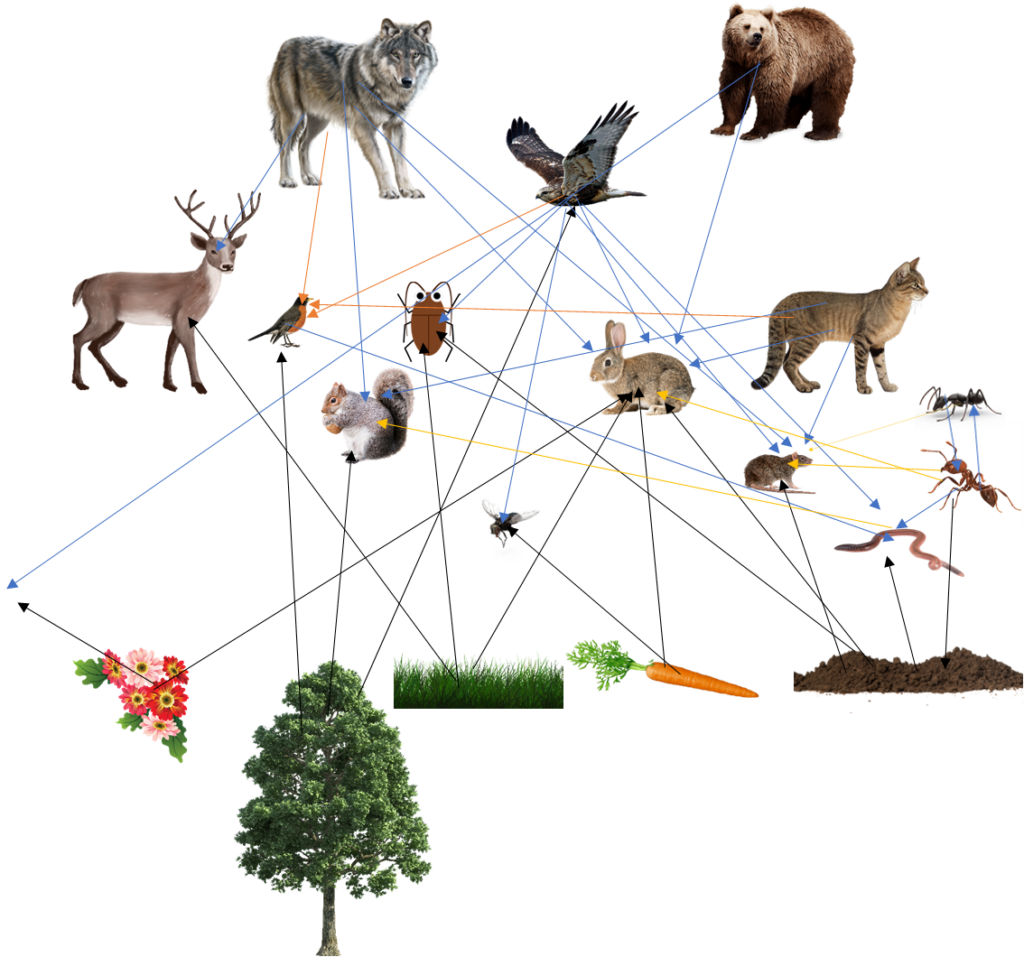My Ecosystem
By
This is a forest ecosystem I have made, it is a forest in the middle of North America, and the species included in this ecosystem are
Wolf: The wolf, also known as the gray wolf or grey wolf, is a large canine dog from Europe and Asia and North America, it is fluffy often found in packs and has sharp teeth.,
Bear: Bears are carnivoran mammals of the family Ursidae, they are very large and had overwhelming strength and has sharp teeth. They are classified as caniforms, or doglike carnivorans. Although only eight species of bears are extant, they are widespread, appearing in a wide variety of habitats throughout the Northern Hemisphere and partially in the Southern Hemisphere ,
Hawk: Hawks are birds of prey of the family Accipitridae. They are widely distributed and are found on all continents except Antarctica. The family Accipitrinae which includes goshawks, sparrowhawks, sharp-shinned hawks and others. These are mostly woodland birds with long tails and high visual acuity , it is vey agile and has an sharp beak
Deer: Deer or true deer are hoofed large mammals forming the family Cervidae,
Robin: The American robin is a migratory bird of the true thrush genus and Turdidae, the wider thrush family, they are small and has an red underbelly
Cockroach: Cockroaches are generalized insects with few special adaptations, and may be among the most primitive living Neopterin insects, they are tiny some can fly but all are generally disgusting
Rabbit: Rabbits, also known as bunnies or bunny rabbits, are small cute mammals in the family Leporidae of the order Lagomorpha. Oryctolagus cuniculus includes the European rabbit species and its descendants, the world’s 305 breeds of domestic rabbit, stereotypically they eat carrots and other veggies.
Wild Cat: The wildcat is a species complex comprising two small wild cat species: the European wildcat (Felis silvestris) and the African wildcat (F. lybica), they are agile and has sharp teeth and claws
Rat: Rattus is a genus of muroid rodents, all typically called rats. However, the term rat can also be applied to rodent species outside of this genus, they are small and loves infesting homes, they can carry diseases too.
Squirrel: Squirrels are members of the family Sciuridae, a family that includes small or medium-size rodents. The squirrel family includes tree squirrels, ground squirrels, and flying squirrels. Squirrels are indigenous to the Americas, Eurasia, and Africa, and were introduced by humans to Australia, they are small and fuzzy and commonly inhabit trees.
Black Ant: The black garden ant (Lasius niger), also known as the common black ant, is a formicine ant, the type species of the subgenus Lasius,
Red Ant: Fire ants are several species of ants in the genus Solenopsis, which includes over 200 species. Solenopsis are stinging ants, and most of their common names reflect this, for example, ginger ants and tropical fire ants ,
Worm: worm, any of various unrelated invertebrate animals that typically have soft, slender, elongated bodies, and tthey help gardens and plants grow.
Fly: fly, (order Diptera), any of a large number of insects characterized by the use of only one pair of wings for flight, they are tiny, annoying, and they typically infest homes.

One thing that will affect my ecosystem is deforestation
Deforestation is an mass chopping down of trees, which cause ecological concerns in the area.
if deforestation takes effect in my ecosystem the chipmunks and birds will lose its home and food and may die quickly because of the loss of their protection. with the death of these 2 species, the predators who eat them will start putting more strain on other species and could cause a chain reaction to the collapse. Also with deforestation will comes machine which damages flowers and grass and may trample rabbit homes, which could cause more strain on the ecosystem.
Over Hunting, this will affect my ecosystem by disrupting the food change cycle, if an 3rd trophic level animal such as the rabbit is over hunted it will disrupt both the 2nd and 3rd consumers, which can cause the system’s population to fall, and if it does maybe the other food will grow and could cause disease but if not, the primary consumer or secondary will end up bouncing back.
Do not Mark this, it is still being edited
its done now